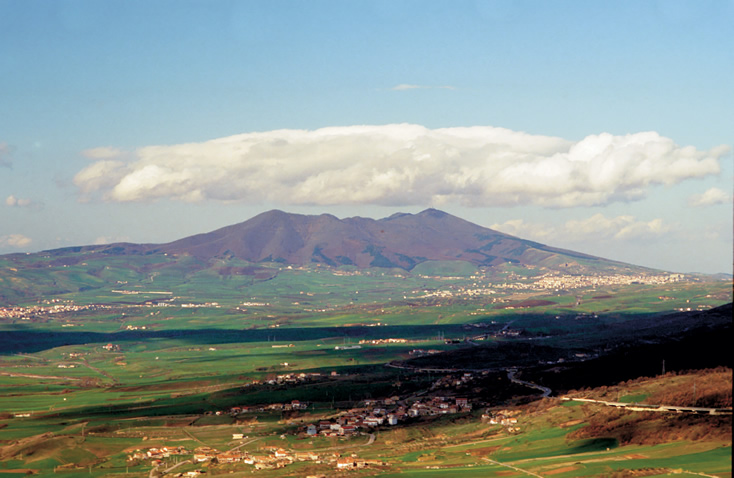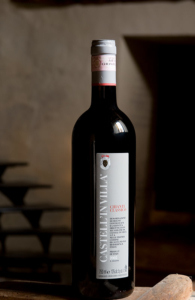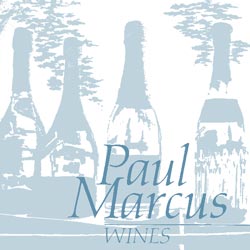Let’s face it: Words like “charm” and “finesse” are not often used to describe aglianico wines. The thick-skinned aglianico grape, which thrives in the warmer climes of Southern Italy, produces wines known for their concentrated dark fruit, robust tannins, and earthy richness. These bottles usually need several years (decades?) to open up, and even then, they can still be knotty, powerful beasts that favor intensity over balance.
However, if you dig a little deeper, you can find aglianico wines that temper that inherent muscle with complex, appealing elements of tobacco, spice, and underbrush. Factor in the grape’s naturally high acidity and the mineral notes imparted from the region’s volcanic soil, and it’s easy to see how–at its best–aglianico can reach heights that few other grapes can achieve.

The slopes of Monte Vulture, an extinct volcano in Basilicata
The two most significant appellations for aglianico are Taurasi, which is about an hour or so east of Naples in the hills of Campania, and Aglianico del Vulture, with its vineyards on the slopes of Monte Vulture in mountainous Basilicata. Generally speaking, Taurasi wines tend to be a bit more vigorous and Vulture wines a tad more restrained–sort of like the Barolo vs. Barbaresco distinction for Piemontese nebbiolo–although there are always exceptions.
At Paul Marcus Wines, we’re fortunate to have a few prime examples of aglianico that find an attractive balance between power and elegance. Let’s start with the 2015 San Martino Aglianico del Vulture Superiore ‘Kamai’–about as graceful and light on its feet as aglianico gets. Made from 60-to-70-year-old vines from a single plot at an altitude of nearly 2,000 feet, this wine undergoes a two-month maceration and ages in wood for about a year before resting in bottle for at least three years. Boasting gorgeous vibrant fruit and loads of acidity, the San Martino feels almost Burgundian in style. (Unfortunately, we only have a few bottles left of this dazzling gem.)
Also from the Basilicata side, we have the 2019 Fucci Aglianico del Vulture ‘Titolo.’ Elena Fucci produces just this one cuvee from her vineyard more than 2,000 feet up in the Titolo lava channel, with most of the vines planted in the 1950s. After a manual harvest, the juice undergoes malolactic fermentation in 100 percent new French oak barrels. Herbaceous and savory, with notes of black tea and exotic spice, this wine will certainly benefit from a few more years of cellaring, but it’s already highly enjoyable (after a bit of decanting) with, say, a hearty bowl of pasta with pancetta, shallots, and sage leaves.
Finally, we have a couple of superb bottlings from Taurasi’s Michele Perillo, coming from some of the highest-elevation vines in the area. The 2010 Perillo Taurasi offers tannic brawn and deep, dark fruit with a freshness and vivacity that you get from the high-altitude vines. Better still is the 2009 Perillo Taurasi Riserva, which is made from Perillo’s best lots of fruit. This wine is softer, rounder, smoother, and more voluptuous than its counterpart, yet still delivers incredible energy and liveliness. These two jewels sell for about half the price of a Barolo of similar quality, and they will sing beautifully with all manner of roasted or braised red meats.
Though nebbiolo and sangiovese rule the roost of Italian red wine, these fine offerings prove that, in the hands of talented winemakers, aglianico can certainly hang with the big boys.
 This beautiful 300-hectare estate in Castelnuovo Berardenga, the southernmost of the Chianti Classico zones, has long been one of the great wine producers in all of Tuscany. The estate (with 54 hectares devoted to vineyards) is owned and led by the formidable Principessa Coralia Pignatelli della Leonessa, with whom I had the good fortune to have lunch with several years back. She is as elegant and charming as you might expect and has a great sense of humor. She got a big kick out of the old joke we told her: “How do you make a small fortune in the wine business? Begin with a large fortune.”
This beautiful 300-hectare estate in Castelnuovo Berardenga, the southernmost of the Chianti Classico zones, has long been one of the great wine producers in all of Tuscany. The estate (with 54 hectares devoted to vineyards) is owned and led by the formidable Principessa Coralia Pignatelli della Leonessa, with whom I had the good fortune to have lunch with several years back. She is as elegant and charming as you might expect and has a great sense of humor. She got a big kick out of the old joke we told her: “How do you make a small fortune in the wine business? Begin with a large fortune.”


